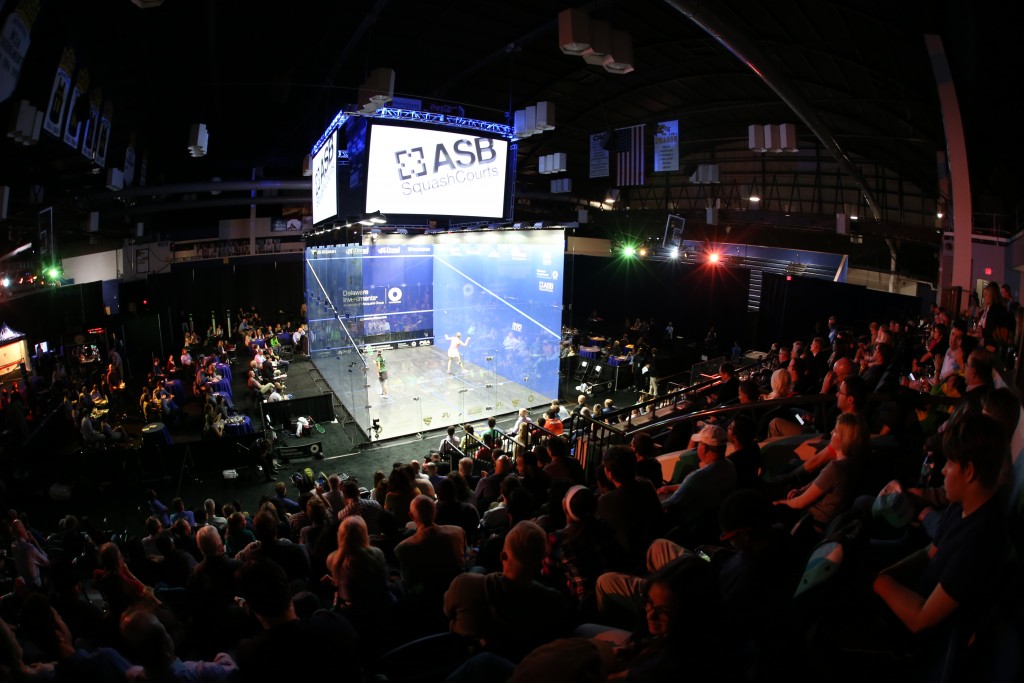by James Zug
Parity is the watchword at the Delaware Investments United States Open. Two years ago, the national championship became the first major in the squash world to have equal prize money for men and women.
Ironically, one of the complaints during the move to parity in 2013, among some hidebound conservatives, was that US Squash was perhaps taking away possible income from the men in order to raise the prize money for women. The theory was wrong at the time and even more wrong in 2015. Rising tides lift all ships. This year the prize money skyrocketed from $115,000 per draw to $150,000. “Parity has been essential to sponsor retention,” said US Squash CEO Kevin Klipstein. “It is something that sponsors demand. Two years ago we helped elevate parity into a top goal of the pro tour and are thrilled to see the idea spread all around the country and the world. People want to be more involved in a sport that equally celebrates men and women.”
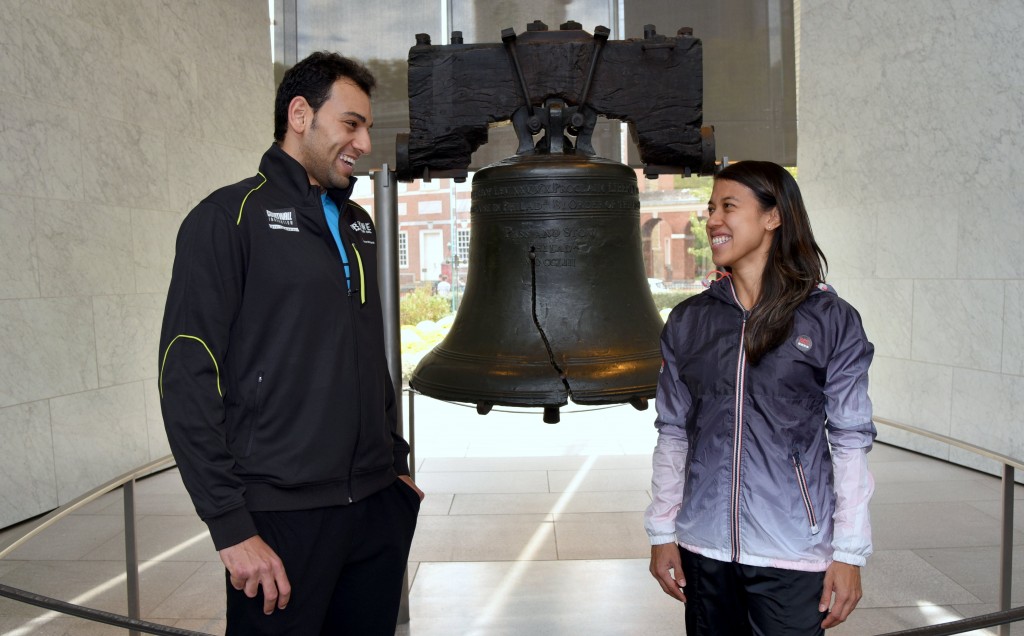
Parity extended, for the first time, to the qualifying tournament. Last year, the women’s qualies included sixteen women vying for eight spots; this year, the qualies doubled to thirty-two women playing not one but two matches in order to grab one of those precious eight main-draw slots. Just like the men.
Moreover, parity meant two inches. The 2015 Open was the first World Series event with women playing on a seventeen-inch tin. The men’s pro tour started to use the seventeen-inch tin (as opposed to the traditional softball height of nineteen) at the 1985 U.S. Open, and it had been standard at all men’s events since 1989.
The PSA officially called the distaff lower tin a trial but the results were convincing. The biggest worry with a lower tin was shorter matches, that the supposedly less-athletic women could not retrieve balls up front and thus each match would resemble two octogenarian men and their very short, monochromatic rallies. Nothing was further from the truth. The matches were riveting and the points long. At the 2014 Delaware Investments U.S. Open, the women’s matches lasted on average forty-three minutes; the men fifty-four minutes. In 2015 the numbers were almost exactly the same: forty-three for women and fifty-five for men.
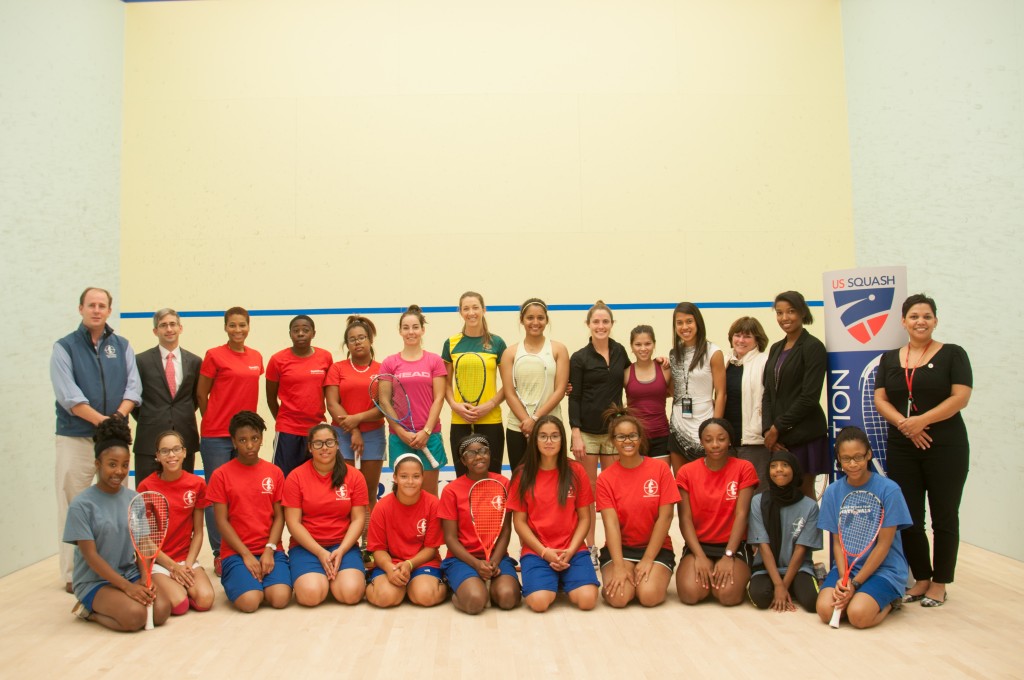
Dipika Pallikal and Jenny Duncalf gave SquashSmarts girls some advice off court,
and then had some fun playing queen of the court.
The other storyline of the ten days of the Open was Egyptian women. One hundred and two women were listed in the January 1993 world rankings; not one was from Egypt. (In case you are scoring at home, eleven Americans were on the 1993 list, as well as nine Japanese.) So it is a remarkable, still untold story of how in the past twenty-two years, professional Egyptian women’s squash has gone from literally zero to literally everything: in 2015 five Egyptians in the top ten, eighteen in the top hundred and female world champions in the open and juniors in both individuals and teams.
The 2015 Open was supposed to see the end of one of the oddest streaks in pro squash: no Egyptian woman has won the U.S. Open. Since 1993 players representing Australia, England, Malaysia, the Netherlands and New Zealand have captured the women’s trophy. No surprise there—those nations are the historical giants of squash. But never an Egyptian.
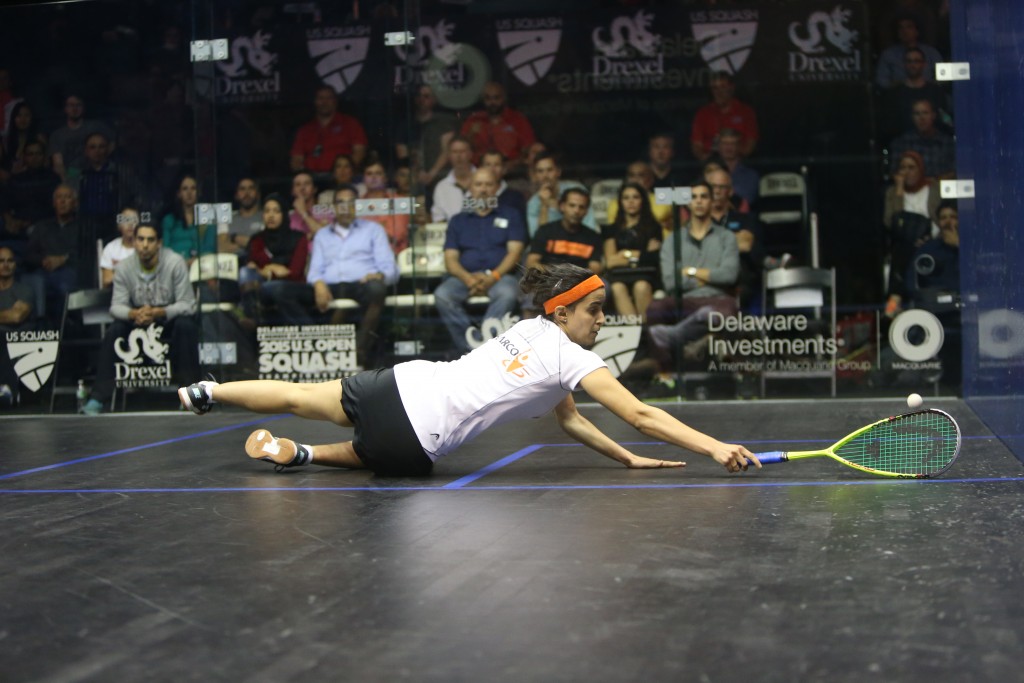
this dive against world No. 1 Raneem El Welily. Incredibly, El Tayeb managed to pull
though the match and go on reach the finals. The injury did require surgery
following the tournament, however.
The lower tin and the Egyptian jinx at the Open concentrated everyone’s attention on Raneem El Welily. The month before she arrived in Philadelphia, El Welily became world No. 1, the highest ranking ever for an Egyptian woman. For a shotmaking, high-octane race car like El Welily, the lower tin was supposed to be the equivalent of the raising of the speed limit. Her agile accelerations and quick-turning flicks were made for the lower tin. Instead, she found herself idling in the garage after a brilliant, 11-9 in the fifth upset in the quarters at the hands of her compatriot Nour El Tayeb. It was perhaps the match of the tournament. “Yes, the lower tin helps with shotmaking,” she told me before the match, “but it also means you have to be quicker to the front wall to get your opponent’s shots, especially boasts.”
The bearded sage of the Open, Amr Shabana, spoke to me about the pressure of the lower tin on El Welily. When the PSA switched from 15 to 11-point scoring in 2004, it looked tailor-made for the aggressive shotmaker. “Everyone came up to me and told me how perfect it was for me, ‘oh, you’ll love it’” Shabana said. “But instead it took me a long time to readjust and recalibrate my game. I didn’t win anything in 2004 because of it.” SquashInfo.com bears it out: after the scoring switch, Shabana lost in twenty straight tournaments over the next twenty months before regaining his winning form.
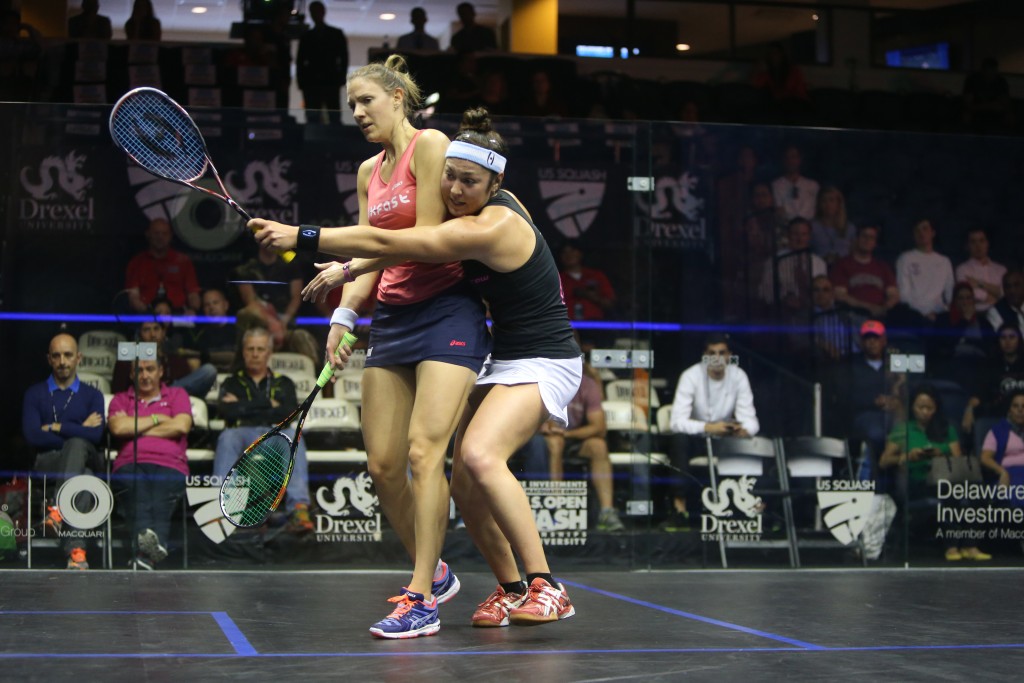
El Tayeb reached her first Grand Slam final at the Open. The twenty-two year-old is coming into her own. She graduated from university in June, with a degree in economics (“the first thing my parents then said was when are you starting your masters?”) and is planning a May 2016 wedding with world No. 33 Ali Farag. (Her fiance lost in the first round in a hard-fought four-gamer to Simon Rösner; Rösner was still sweating after his 270kph race down the Autobahn to catch his flight at the Frankfurt airport to come to the Open.)
A fan favorite in America since she won the world junior title in Boston in 2011, El Tayeb came tantalizingly close to breaking the Egyptian Open jinx herself, grabbing a 2-1 lead in the final against England’s Laura Massaro before succumbing in five. Massaro had another jaws of defeat snap-back tournament. She came back from a 0-2 deficit to knock off three-time defending champion Nicol David in the quarters. Massaro had pulled the exact same rabbit out of her hat in the semis of the British Open in May, coming back from 0-2 down to David (and saving a match ball in the fourth game) to win in five; she then had tripped against Camille Serme in the finals. In Philadelphia she backed up her David upset with two more victories, including the comeback against El Tayeb in the final.
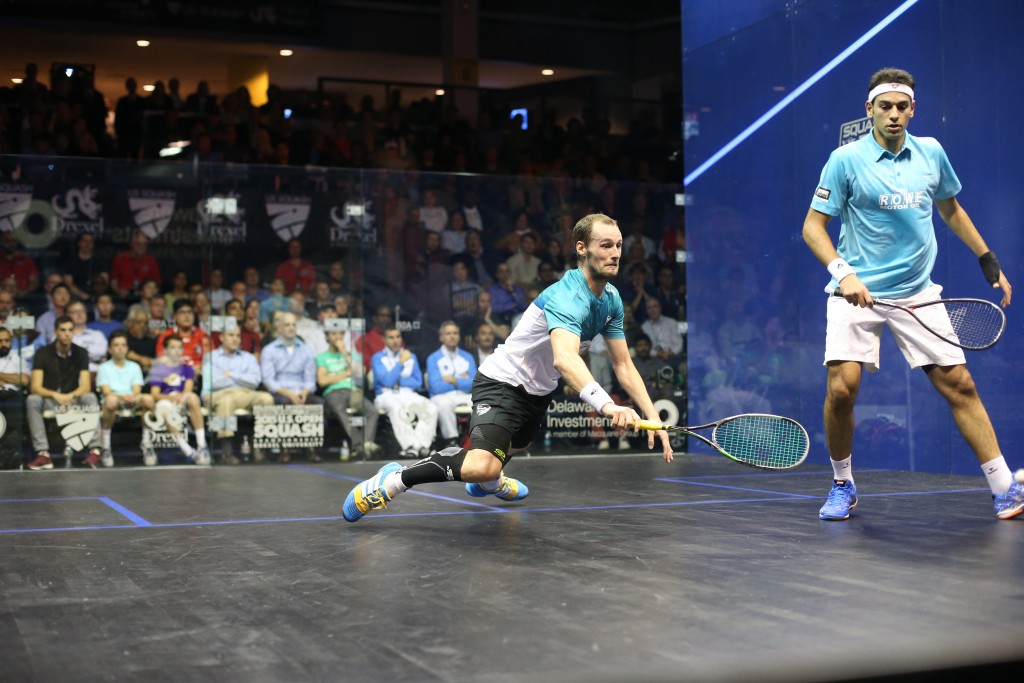
“I had so much emotion after that win over Nicol at the British Open,” Massaro said after grabbing her second U.S. Open title. “The media attention, the excitement of beating Nicol in such a big tournament. I was so drained. This time I promised myself to treat it just like any other win.” Massaro was able to come back against El Tayeb because of her shotmaking up front—exactly the situation what the lower tin was supposed to create. “Nour was playing with such immaculate length. I had to hit my targets and keep the ball in the back corners and then be brave up front and go for it.”
The odds of an Egyptian male making it to the finals were very short—seven of the last sixteen in the men’s draw were Egyptian as were three of the top six seeds—but no one would have predicted the Egyptian finalist would be Omar Mosaad.
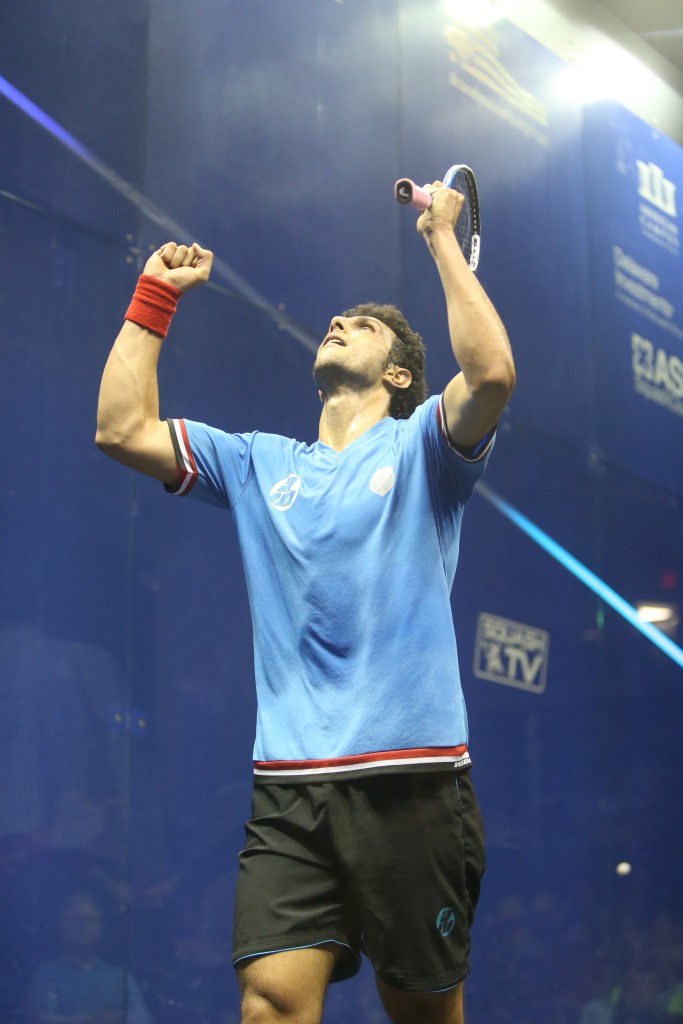
Egyptian reached both his first World Series semifinal and final, and also defeated
Nick Matthew for the first time in the semis.
Mohamed Elshorbagy, the defending champion and world No.1, blew a 2-1 lead against Gregory Gaultier in the semis. Ramy Ashour, the slap-my-face, did-I-really-see-that? virtuoso, was put hors de combat the first game of his second-round match by his balky right-leg hamstring. The preternaturally youthful Fares Dessouki—next in the line of succession—lost in the quarters to the ageless Nick Matthew.
Instead it was the gentle giant, whose forehand is so famous that it is emblazoned on the back of his shirts, who came to the fore and reached his first-ever Grand Slam semis and then final. Mosaad, twenty-seven, suffered a terrible tragedy in July when his mother and older sister were killed in a car accident in Cairo. “Playing squash, getting inside the court, has been a good way to distract me,” Mosaad said. In Philadelphia he annexed two epic tiebreakers in a three-game win over Tarek Momen before dispatching two Englishmen, Daryl Selby and Nick Matthew, to reach the final.
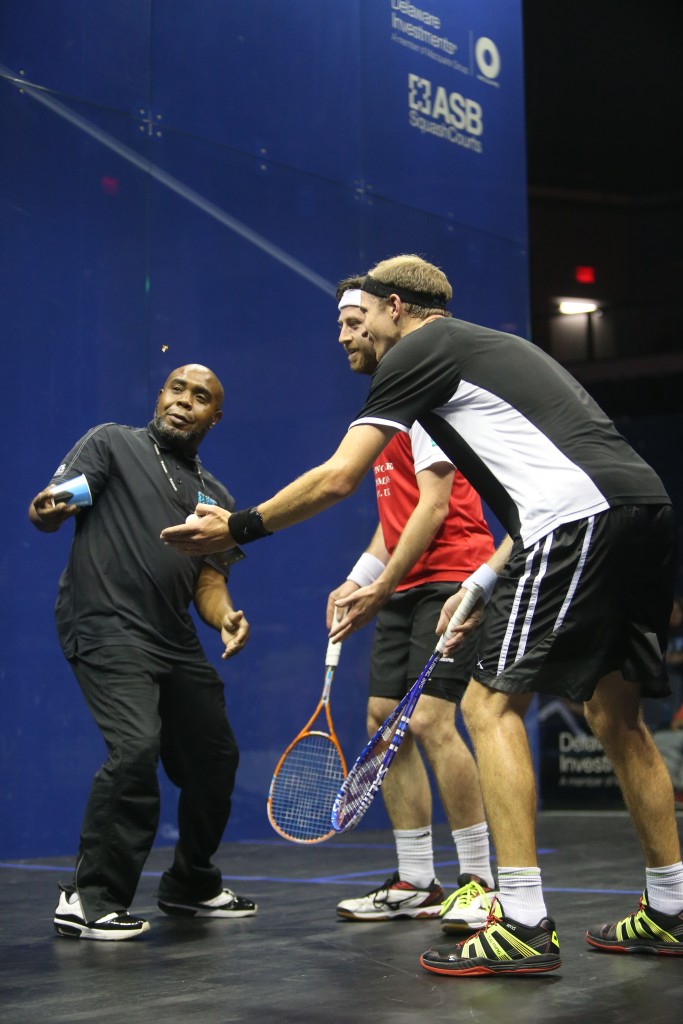
fluttering on court. After Stephen Coppinger (r) and Daryl Selby (m) failed to corral the creature, court attendant Gary Reed (l) gathered it in a cup and escorted it to safety.
But Gregory Gaultier was waiting. Gaultier, Open champion in 2006 and 2013 and soon to turn thirty-three, swallowed the draw whole, his only hiccup being his semis match against Elshorbagy. Gaultier brimmed with confidence. He had a solid team of support staff with him, including the French national coaches Philippe Signoret and Renan Lavigne, the former world No. 17.
His victory was reminiscent of his 2013 Open triumph when he chopped Nick Matthew in three quick games in the final. Gaultier is perhaps the best at removing superfluities from his game. Every ball is clean, crisp. When he marshals his emotions, when he manages squash’s puzzlingly twined requirements of ferocity and passivity, when he doesn’t feel affronted by the referee’s decisions, the French General is virtually unstoppable. Only one person, Cassie Jackman, has a better Open career record than Gaultier: she won four titles to his three and did it over a ten-year period, as opposed to his nine year gap. If he takes the 2016 title, Gaultier will tie her in both categories.
For Americans, the Open was as promising as it has been in years, especially for women. Amanda Sobhy reached the second round and pushed the eventual champion Massaro to four tough games. Olivia Blatchford qualified in and then nipped a game off Camille Serme in the opening round. In the qualies Princeton’s stars performed above their pay grade as Maria Elena Ubina took Line Hansen to five and Olivia Fiechter grabbed one game and almost another against Samantha Teran. In the men, Chris Gordon went down in three in the opening round to Selby. Of the six Americans in the men’s qualies, just Todd Harrity extended his match beyond the minimum, when he grabbed one game and went into tiebreakers in two others against Raphael Kandra. (The biggest excitement of the qualies surely emerged from Drexel coach John White who outlasted Adrian Grant 11-9 in the fifth.)
It was the fifth straight October with the Open at Drexel and the image of the ASB GlassCourt with the four giant video screens above (attached to the basketball arena’s four-sided Jumbotron) is now iconic. The crowds were packed and boisterous, especially in the latter half of the event. Eric Zillmer, Drexel’s athletic director, wrote in the student newspaper about why: “Squash, at the world-class level, reminds me of a combination between a Cirque de Soleil performance in Montreal and a Garry Kasparov versus Bobby Fischer chess match in Reykjavik.” It might not be exactly historically correct, but such a statement hints at the excitement and intrigue available only live at the Open. With so many ancillary receptions, luncheons, conferences, parties, tournaments and activities, the Open is now truly a world-class celebration.
